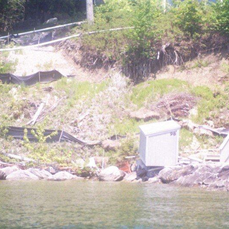Quote:
Originally Posted by Natt

This is just why the Shoreland Water Quality Protection Act is so critical for the lake and the regional economy.
|
You are correct.
Erosion adds silt and unnecessary "nutrients" into the lake—contributing to the recent algae growth that spreads the dreaded "Duck Itch".
Runoff from
all steep lots forms an ideal substrate for the spreading of milfoil and other "invasive-exotics".
In a previous photo, you can see at least one stump was left in place, but even those "required" stumps weren't sufficient to hold back the landslide. This was a heavily-forested shoreline when I was growing up here. It depends on one's perspective, but trees get cut down—to "improve the view of the lake".

Though long-delayed at that site, the first mitigation attempt was the erecting of the usual "soil fences":

You can see how
that worked out.

In the lakefront lot next door to me, a leachfield got a wash-out a few years ago, and appears as a moonscape

Septic-PVC appear as the white objects in the photo.

There are many more photos of Lake Winnipesaukee erosion in this computer—taken
just by me—but I think I'll stop about here.
